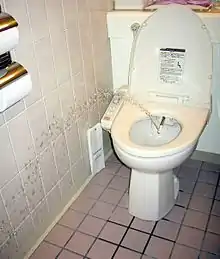
There are two styles of toilets commonly found in Japan. The oldest type is a simple squat toilet, which is still common in public conveniences. After World War II, modern Western-type flush toilets and urinals became common. The current state of the art for Western-style toilets are the bidet toilets, which, as of 2004, are installed in more than half of Japanese households. In Japan, these bidets are commonly called Washlets, a brand name of Toto Ltd., and include many advanced features rarely seen outside of Asia. Depending on the exact model, these bidets are designed to open the lid when they sense a user nearby, wash the anus or vulva of the user (including a number of pulsating and massaging functions), dry afterwards with warm air, flush automatically and close the lid after use. During the Jōmon period, settlements were built in a horseshoe shape, with a central plaza in the middle and garbage heaps around the settlement. In these garbage heaps, calcified fecal remains of humans or dogs, so called coprolites, were found, indicating that these garbage dumps were also used as toilets. The earliest sewer systems are from the Yayoi period (300 BC to A.D. 250). These systems were used in larger settlements, probably in combination with toilets. A possible ritual site, that may also have been a toilet using flowing water, dating back to the early 3rd century was found in Sakurai, Nara. Another cesspit analyzed by archaeologists in detail was found at the site of the Fujiwara Palace in Kashihara, Nara, the first location of the imperial city from 694 to 710. This toilet was constructed over an open pit similar to an outhouse. (Full article...)